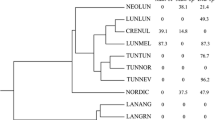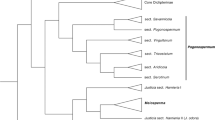Abstract
Botrychium campestre and B. lineare have, since their original descriptions, been considered closely related due to their morphological similarity. Although B. lineare was initially thought to be very rare, subsequent discoveries of many additional populations, especially in the Rocky Mountains and Sierra ranges, have afforded the opportunity to analyze hundreds of specimens on the basis of allozyme genetics. Surprisingly, B. lineare demonstrates a high degree of heterozygosity, implying an outcrossing breeding system, unlike the mostly homozygous, selfing B. campestre. However, overall levels of Nei’s Genetic Identity between the two taxa are higher than usual between species. With this knowledge, we infer that taxon lineare is probably ancestral within complex, and that taxon campestre arose from within it as an adaptation to more xeric habitats. Given that B. campestre has nomenclatural priority, we propose to recognize lineare as a variety within a more broadly construed campestre, i.e., Botrychium campestre var. lineare, and suggest that hybrid or introgressed plants, such as rarely occur (e.g., at Glacier National Park and in the Black Hills of South Dakota) be referred to only at the specific rank, i.e., without reference to variety


Similar content being viewed by others
Literature cited
Cayouette, J. & D. R. Farrar. 2009. Slender moonwort, Botrychium lineare (Ophioglossaceae), rediscovered in Quebec. The Canadian Field-Naturalist 123: 255–259.
Crawford, D. J. 1989. Enzyme electrophoresis and plant systematics. Pages 146–164. In: D. E. Soltis & P. S. Soltis (eds.). Isozymes in plant biology. Dioscorides Press, Portland.
———. 1995. Electrophoretic data and plant speciation. Systematic Botany 10: 405–416.
Dauphin, B., J. Vieu & J. R. Grant. 2014. Molecular phylogenetics supports widespread cryptic species in moonworts (Botrychium s.s., Ophioglossaceae). American Journal of Botany 101: 128–140.
Farrar, D. R. 1998. Population genetics of moonwort Botrychiums. Pages 109–113. In: N. Berlin, O. Byers, J. Borovansky, P. Miller & U. S. Seal (eds.), Population and habitat viability assessment (PHVA) for the goblin fern (Botrychium mormo). Conservation Breeding Specialist Group (CBSG), Apple Valley, Minnesota.
———. 2001. Isozyme characterization of moonwort ferns (Botrychium subgenus Botrychium) and their interspecific relationships in northwestern North America. Final report to the Colville National Forest, Colville, Washington.
———. 2005. Systematics of western moonworts Botrychium subgenus Botrychium. In: Popovich, S. J. (ed.), United States Forest Service moonwort workshop. Arapaho-Roosevelt National Forests and Pawnee National Grassland, Fort Collins, Colorado.
———. 2009. Determination of the taxonomic relationship between Botrychium lineare and Botrychium campestre. US Fish and Wildlife Service Report 10181-5-M847.
———. 2012. Ophioglossaceae and Botrychium. Pp. 119–123. In: B. G. Baldwin, D. H. Goldman, D. J. Keil, R. Patterson, T. J. Rosatti & D. H. Wilken (eds.), The Jepson manual: vascular plants of California, 2nd ed. University of California Press, Berkeley.
———, & C. L. Johnson-Groh. 1990. Subterranean sporophytic gemmae in moonwort ferns, Botrychium subgenus Botrychium. American Journal of Botany 77: 1168–1175.
———, & S. J. Popovich. 2010. Ophioglossaceae of Colorado, adjacent states, and southwest South Dakota. Native Plant Society of New Mexico Moonwort Workshop. Silver City,Colorado.
Felsenstein, J. 1989. PHYLIP—Phylogeny Inference Package (Version 3.2). Cladistics 5: 164–166.
Gilman, A. V. 2015. New flora of Vermont. Memoirs of the New York Botanical Garden 110: 1–614.
———, D. R. Farrar & P. F. Zika. 2015. Botrychium michiganense sp. nov. (Ophioglossaceae), a new North American moonwort. Journal of the Botanical Research Institute of Texas 9: 295–309.
Hamrick, J. L. & M. M. W. Godt. 1990. Allozyme diversity in plant species. In: A. H. D. Brown, M. T. Clegg, A. L. Kahler, & B. W. Weir (eds.), Plant population genetics, breeding, and genetic resources. Sinauer Associates, Inc., Sunderland, Massachusetts.
Hartl, D. L. & A. G. Clark. 1997. Principles of population genetics. Sinauer Associates, Sunderland, Massachusetts.
Hauk, W. D. 1995. A molecular assessment of relationships among cryptic species of Botrychium subgenus Botrychium (Ophioglossaceae). American Fern Journal 85: 375–394.
Hauk, W. D. & C. H. Haufler. 1999. Isozyme variability among cryptic species of Botrychium subgenus Botrychium (Ophioglossaceae). American Journal of Botany. 86: 614–633.
Hauk, W. D., L. Kennedy & H. M. Hawke. 2012. A phylogenetic investigation of Botrychium s.s. (Ophioglossaceae): evidence from three plastid DNA sequence datasets. Systematic Botany 37: 320–330.
Johnson-Groh, C. L. & D. R. Farrar. 1993. Population dynamics of prairie moonworts (Botrychium subgenus Botrychium) in Iowa and Minnesota. American Journal of Botany 80: 109 [Abstract].
Johnson-Groh, C. L., C. Riedel, L. Schoessler & K. Skogen. 2002. Belowground distribution and abundance of Botrychium gametophytes and juvenile sporophytes. American Fern Journal 92: 80–92.
Nei, M. 1978. Estimation of average heterozygosity and genetic distance from a small number of individuals. Genetics 89: 583–590.
Ranker, T. A. & J. M. O. Geiger. 2008. Population genetics. Pages 107–133. In: T. A. Ranker & C. H. Haufler (eds.), Biology and evolution of ferns and lycophytes. Cambridge University Press, Cambridge, UK.
Sessa, E. B., W. L. Testo & J. E. Watkins. 2016. On the widespread capacity for, and functional significance of, extreme inbreeding in ferns. New Phytologist 211(3): 1108–1119.
Soltis, D. E., C. H. Haufler, D. C. Darrow & G. J. Gastony. 1983. Starch gel electrophoresis of ferns: A compilation of grinding buffers, gel and electrode buffers, and staining schedules. American Fern Journal 73: 9–27.
Soltis, D. E. & P. S. Soltis. 1989. Polyploidy, breeding systems, and genetic differentiation in homosporous pteridophytes. Chapter 12. In: Soltis, D. E. & P. S. Soltis (eds.), Isozymes in plant biology. Dioscorides Press, Portland, Oregon.
——— & ———. 1996. Electrophoretic evidence for inbreeding in the fern Botrychium virginianum (Ophioglossaceae). American Journal of Botany 73: 588–592.
Stensvold, M. C., C. L. Johnson-Groh & D. R. Farrar. 2002. Two new species of moonworts (Botrychium subg. Botrychium) in Alaska. American Fern Journal 92: 150–160.
Wagner, W. H. Jr. & F. S. Wagner. 1986. Three new species of moonworts (Botrychium subg. Botrychium) endemic in western North America. American Fern Journal 76: 33–47.
——— & ———. 1993. Ophioglossaceae C. Agardh., adder's-tongue family. Pp. 85–106. In: Flora of North America Editorial Committee (eds.), Flora of North America, North of Mexico, vol. 2: Pteridophytes and Gymnosperms. Oxford University Press, New York.
——— & ———. 1990. Moonworts (Botrychium subg. Botrychium) of the Upper Great Lakes Region, U.S.A. and Canada, with description of two new species. Contributions of the University of Michigan Herbarium 17: 313–325.
——— & ———. 1994. Another widely disjunct, rare, and local North American moonwort (Ophioglossaceae: Botrychium subg. Botrychium). American Fern Journal 84: 5–10.
Yeh, F. C. & T. J. B. Boyle . 1997. Population genetic analysis of co-dominant and dominant markers and quantitative traits. Belgian Journal of Botany. 129: 157.
———, R.-C. Yang, T. Boyle, Z.-H. Ye & J. X. Mao 1997. PopGene, the user-friendly shareware for population genetic analysis. Molecular Biology and Biotechnology Centre, University of Alberta, Canada.
Zika, P. F. & D. R. Farrar. 2009. Botrychium ascendens W. H. Wagner (Ophioglossaceae) in Newfoundland and notes on its origin. American Fern Journal 99: 249–259.
Acknowledgements
We gratefully aknowledge support of this study by the USDI Fish and Wildlife Service, the USDA Forest Service, the National Parks Service, and Parks Canada. Individually we are especially appreciative of logistical support provided by Steve Popovich, Cheryl Mayer, and Mary Stensvold in key areas of Colorado, the Black Hills of South Dakota and Wyoming, and Alaska, respectively. Chanda Skelton provided invaluable expertise in enzyme electrophoresis as well as field work. Numerous individuals are thanked for contributing specimens from across the broad range of Botrychium campestre in the US and Canada. We also thank two anonymous reviewers for helpful comments and guidance.
Author information
Authors and Affiliations
Corresponding author
Electronic supplementary material
Below is the link to the electronic supplementary material.
Suppl. Material 1
Collection data for specimens analyzed and discussed relative to establishment of genetic identification and comparisons of Botrychium campestre and B. campestre var. lineare. Population numbers are unique identifiers of population samples at a given site on a given day. Two or more populations of a species sampled on the same day but at different localities are differentiated by addition of a letter. E-number ranges (Column A) assign individual numbers to each plant collected and its associated genetic profiles (not included) as established through enzyme electrophoresis (see Methods) of large population samples with uniform genetics and morphology; not all samples were tested. Most collections were acquired through government natural areas species inventories that varied in location precision. (XLSX 78 kb)
Rights and permissions
About this article
Cite this article
Farrar, D.R., Gilman, A.V. Relationships in the Botrychium campestre (Ophioglossaceae) complex. Brittonia 69, 265–275 (2017). https://doi.org/10.1007/s12228-017-9467-3
Published:
Issue Date:
DOI: https://doi.org/10.1007/s12228-017-9467-3




